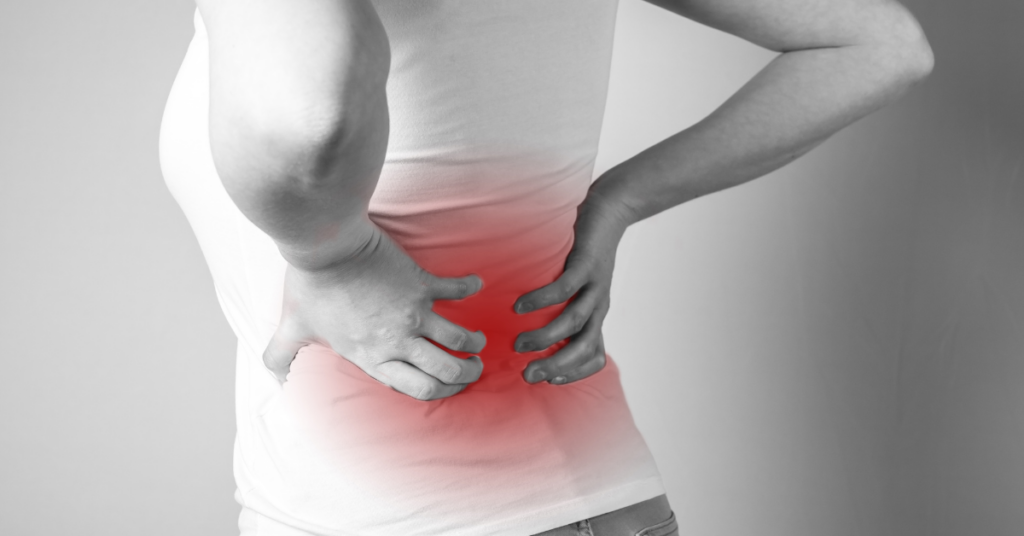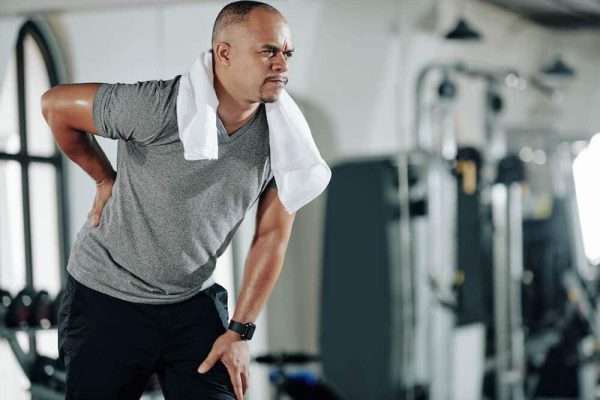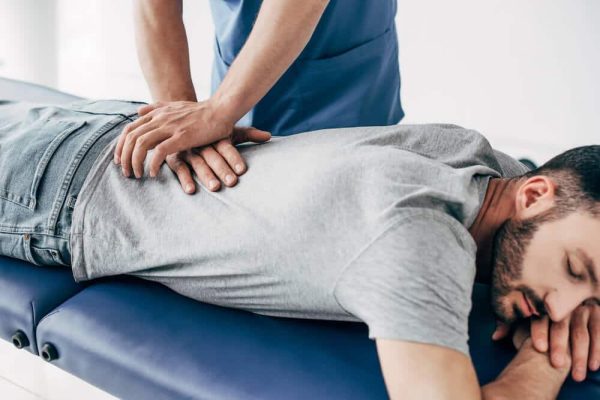How To Treat Back Spasms: 5 Ways To Relieve Back Spasms

What Is a Back Spasm?
Anyone who has experienced a back spasm knows that it is extremely discomforting, as they can weaken your muscles and affect your spine’s health negatively. Fortunately, you don’t have to keep struggling with this condition.
If you’re tired of ineffective treatments for back spasms, you’ve come to the right place. Keep reading this article to discover simple, trusted remedies for relief. We’ll help you understand the different causes of back spasms, home treatment methods, and how you can prevent it from occurring.

A back spasm is a sudden sharp pain caused by the involuntary contraction of your back muscles. It’s difficult to pinpoint the exact reasons why this happens, although experts suggest that sleeping awkwardly, bending, lifting, standing, or sitting can all be causes. Back spasms can also be caused by injuries or overworking.
Typically, back spasms ease with time and require light home treatment. For example, massaging your back with an ice pack or hot water can provide significant relief. Changing your habits and avoiding strenuous exercises that put pressure on your back muscles are other practices you can embrace for back spasm recovery.
Often times, engaging in normal activities will help you recover from back muscle spasms. However, if you have pre-existing medical conditions, you will require additional care and medical advice.
In Burnaby, where residents enjoy an active lifestyle thanks to our beautiful parks and trails, understanding and addressing back spasms is crucial to maintaining your activity levels and overall health.
What Do Back Spasms Feel Like?

Typically, a back spasm lasts anywhere between a few seconds to nearly 15 minutes. During this time, you will experience a tight or knot-like twitch in your muscles or some sort of contraction. When this tightness eases off, your muscles start to feel tender and sore.
In some cases, your healthcare provider might prescribe muscle relaxants like acetaminophen or over-the-counter non-steroidal anti-inflammatory drugs like ibuprofen and naproxen to relieve pain and stiff muscles.
What Causes a Back Spasm?

A mild strain is one of the minor causes of back spasms. However, for some others, back spasms are triggered by more complex conditions such as a herniated or ruptured spinal disc. If you feel like your back muscles are moving or contracting firmly, you should look out for the following common causes.
Bad Posture
The way you sit at your desk or in a car can strain your back muscles and trigger spasms. Some people make the mistake of adjusting their posture to deal with the spasms, which worsen their condition.
Lack of Exercise
With the rise of remote work, many people spend their time at a work desk, hunched over a computer screen, with little or no chance for exercise.
Dr. Kimiya Sabbaghan, Chiropractor in Coquitlam, adds that prolonged sitting doesn’t just weaken the lower back—it also reduces mobility in the hips and mid-back. She explains that these two regions are designed to move frequently, and when they stiffen, the lower back has to compensate with extra motion. This compensation increases the likelihood of spasms, especially during simple activities like bending, reaching, or even standing up from a chair.
The more you do this, the weaker and more inflamed your muscles will get. This can trigger painful muscle spasms as your back muscles struggle with inflammation caused by prolonged weakness.
To remedy this, take breaks from your desk for some exercise. Even 10 to 15 minutes of brisk walking can help.
Overuse of Your Lower Back Muscles

When you’re trying a new exercise, you might put a lot of pressure on your lower back muscles, which can trigger muscle spasms for a few days. Some people might experience a form of post-exercise pain known as delayed onset muscle soreness (DOMS).
Nerve Damage
Conditions linked to nerve damage such as diabetes, spinal cord damages, and radiculopathy can cause spasms and pain. Radiculopathy causes inflammation, compression, or injury to a nerve root in the spine, resulting in tingling or pain in the muscles.
Sciatica is another condition that can trigger back spasms. This occurs when there’s a compression of the nerve roots that make up your sciatic nerves. Sciatica often results in a sharp pain that affects your buttocks, legs, and some parts of your lower back.
Stress
Activities that cause stress and anxiety can trigger lower back spasms. When you’re stressed or anxious, you’d become less willing to engage in physical activities and this can cause muscle stiffness. Typically, your body reacts to stress by producing more adrenaline and making your muscles tense.
Spondylolisthesis
Spondylolisthesis happens when your vertebra shifts forward relative to the bone below having instability from a special type of injury called a pars fracture. When this happens, some parts of your spine move out of their original position. This spinal condition is one of the leading causes of muscle spasms and back pain and can be diagnosed via an X-Ray.
Arthritis

Although arthritis isn’t a direct trigger for back spasms, you might experience this condition as one of its many side effects. Arthritis causes inflammation of your joints, which can weaken your muscles and cause spasms.
Spinal Stenosis
People with spinal stenosis experience muscle pain, weakness, and numbness as the condition worsens. Spinal stenosis causes the spinal canal to narrow over time which puts pressure on the nerves, causing painful spasms. If left untreated, spinal stenosis can lead to nerve damage, paralysis, and eventual death of the patient.
For Burnaby residents, everyday activities such as hiking the Burnaby Mountain, cycling around Deer Lake, or long commutes can contribute to the risk factors associated with back spasms.
5 Ways to Relieve a Back Spasm

Several home remedies can provide relief for back spasms, especially in the early stages of the condition. A simple shift in your daily habits such as exercising regularly and good posture will set you on the right road to recovery. Common relief methods for back spasms include:
- Stretching the area of the spasm
- Massaging your lower back
- Applying ice and heat to your back
- Getting active and hydrated
- Treating back spasms by visiting a licensed chiropractor
Dr. Jaspreet ‘Jas’ Nijjer, an experienced chiropractor, emphasizes the significance of chiropractic care in managing back spasms. If you’re grappling with persistent back spasms that resist home remedies, seeking the expertise of a licensed chiropractor can be highly beneficial. Chiropractic care focuses on identifying the root cause of your muscle spasms and providing targeted treatment, often involving spinal adjustments, soft tissue therapies, and personalized exercise routines. This holistic approach not only alleviates symptoms but also addresses underlying causes, promoting spinal health and preventing future spasms. Chiropractic care offers a safe, gentle, and tailored option for those seeking relief from back spasms, making it a valuable addition to your wellness journey.
Given the diverse lifestyle in Burnaby, from outdoor enthusiasts to those working in office settings, these five relief methods can be easily adapted to fit your routine and environment.
Let’s get into the specifics of each remedy in detail.
Stretching the Area of the Spasm
Stretching the muscles around your back can provide almost immediate relief from spasms or stop them from occurring altogether. Before stretching your back muscles, you should take some time to walk around and loosen your muscles. Sometimes, this may provide the relief you need.
Common back stretches for back spasms include the tennis ball stretch, foam roller stretch, and exercise ball stretch. These stretches are particularly beneficial after enjoying a walk in Central Park or preparing for a day at the office in Metrotown, helping Burnaby residents stay flexible and prevent spasms.
How to Do Tennis Ball Stretches
- Lie down on the floor or a bed with a tennis ball or another ball of similar size. Place the ball under the area with the spasm for a few minutes.
- Try to relax and breathe normally.
- Move the ball to an adjacent spot and repeat the exercise until you feel relief.
How to Do the Foam Roller Stretch

- Place a foam roller perpendicular to your spine and lie down on the floor.
- Cross your arms on your chest.
- Move your back over the roller, up to your shoulder blades, and down to your belly button.
How to Do Exercise Ball Stretches

- Stretch out your back, shoulders, and buttocks on an exercise ball. Make sure your feet are flat on the floor.
- Remain in this position for a few minutes. For better balance, you should do this near a chair or couch.
Massaging Your Lower Back
Sometimes, a good back massage may relieve the pain and discomfort that comes with muscle cramps and back spasms.
If you cannot get a professional massage, you can try out a home alternative. Gently rub the affected area of the muscle spasm over and over again, until you feel some sort of relief.
If you’re experiencing persistent back spasms, consider pinching the area around the sensations and holding the pinch for a few minutes. You can ask someone to help out if your hands can’t reach the area.
Consider using local Burnaby wellness resources, like parks and relaxation spaces, as calming environments to practice these self-massage techniques.
Applying Cold Packs and Heat to Your Back

Regular hot or cold therapy can loosen the tightness around your back muscles and relieve spasms. Both therapies help to relax your muscles and ease the side effects of muscle spasms.
Hot Therapy for Muscle Spasms
Apply a heating pad to the area around the spasms for 15 to 20 minutes. After this, massage the area with a cold compress to calm any inflammation caused by the heating pad.
If you’d rather do without the pad, try having a warm bath, hot tub or spa session, or a hot shower.
Cold Therapy for Muscle Spasms
Wrap the ice pack with a cloth so it doesn’t have direct contact with your skin, and apply it on your back muscles for 15 to 20 minutes. Do this several times a day for maximum relief, taking breaks in between.
Getting Active and Hydrated

Staying hydrated is a great way to relieve back spasms quickly. This is even more important if you live in a warm area or your job requires exerting lots of physical energy.
Generally, experts recommend that you drink eight 8-ounce glasses of water, which is about two litres, or half a gallon of water every day. In reality, your actual water intake would depend on your individual needs, lifestyle, and prevailing weather conditions. Here’s a simple table you can use as a reference.

Staying active in Burnaby is easy with our numerous parks and recreation centers. Regular hydration is especially important during our dry summer months or when enjoying indoor activities at places like the Bonsor Recreation Complex.
Treating Back Spasms with Chiropractic Care

If your back spasms start to worsen, you might consider visiting a local Burnaby chiropractor. Wondering what chiropractic care involves and if it’s suitable for you? Find answers in our article on what a chiropractor does. Here, you can get expert advice and chiropractic care for pain relief of muscle spasms.
During your initial visit, your chiropractor will determine the cause of your muscle spasm. If it is caused by strain or injury, they might perform spinal adjustments or soft tissue therapy to ease the pain and discomfort.
However, if the chiropractor finds an issue with a spinal disc, then you may require different treatment or further imaging. The requisite rehabilitation may involve different exercises and stretches. In some instances, you may also be referred back to your medical doctor for additional care.
If you’re worried about the treatment hurting, don’t worry – chiropractic care is gentle and is always a discussion between you and the treating practitioner.
How to Prevent Back Spasms
Simple changes to your health habits can protect your lower back and prevent back spasms. Let’s look at a few things you can do.
Maintain Good Posture

Maintaining good posture reduces the pressure on your back muscles and ligaments, which can prevent tightening and discomfort. For a deeper understanding of good posture and its importance, delve into our dedicated article. Some tips for a good sitting posture include:
- Relaxing your shoulders
- Placing your ankles in front of your knees
- Keeping your feet flat
- Maintaining a slight gap between the back of your knees and the chair
- Resting your back against the chair
- Sitting up straight and looking forward without straining your neck
Properly Lift Heavy Objects
If you lift heavy objects suddenly, you will strain your lower back and compress your spinal discs, all of which can trigger muscle spasms. One of the most important things you should have in mind is, “never turn or twist your body while lifting or holding a heavy object.” When it comes to handling unexpected situations like car accidents, explore our article on what to do after a car accident to stay informed. Here are some tips for proper lifting.
- Keep a wide base of support for the load. To achieve this, you should take a karate stance: Your feet should be shoulder-width apart, with one foot slightly ahead of the other.
- Take a half-kneeling or squatting position; this way, you’d have a good grasp of the load.
- Maintain a good posture. Look straight ahead, and keep your back straight, your chest out, and your shoulders back.
- When dropping the load, squat with your knees and hips only.
- Don’t lift the weight with your back. Instead, slowly lift the heavy object by straightening your knees and hips.
Exercise Regularly
Exercising regularly can strengthen your back muscles and prevent spasms. Explore our article on stretches for low back pain relief to discover specific exercises that can contribute to a healthier back. Some strengthening exercises you can try out to prevent lower back pain include:
- Partial crunches (while maintaining neutral spine)
- Stretches
- Wall sits
- Press-up back extensions
- Pelvic tilts
If your work keeps you seated at your desk for an extended period, you should plan for frequent walk breaks — stroll around your home, or take a brisk walk outside. Also, consider enrolling in an exercise program.
Apart from relieving chronic low back pain and muscle spasms, exercises have several health benefits such as improving your blood flow and mental health. It also helps you to burn off extra calories. If you’re looking for exercises that can alleviate foot pain, explore our article on plantar fasciitis exercises. It can be helpful in maintaining your overall physical health.
Summary
There’s no reason to keep struggling with back spasms. With the right treatment methods plus healthier habits, you can get rid of muscle spasms for good, and enjoy a better life. If you’re dealing with hip pain, explore our article on treating hip pain to address another common discomfort.
Did you enjoy this article? Sign up to our mailing list today for more health tips—we’d also provide you with our free series of E-books!
Don’t let back spasms limit your life. Take the first step towards a pain-free future. If you’re in the Burnaby area and need expert chiropractic care, our Burnaby Chiropractor services are here to help. We’re dedicated to providing relief and promoting overall wellness. Contact us today to schedule a consultation and start your journey towards a healthier, pain-free you. Your comfort and well-being are our priorities. Join our mailing list for more valuable health tips, and explore our free series of E-books to enhance your understanding of various health-related topics.
